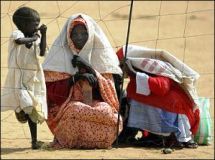A Sudanese city of refugees with no plans to go home
By JOEL BRINKLEY, The New York Times
ABUSHOUK, Sudan, April 16 — Stand at the center of this teeming refugee camp and the tents, mud huts and lean-tos stretch all the way to the horizon – to the north, the south, the east and the west.

|
|
Sudanese refugees rest near a fence at the Abu Shouk refugee camp. (AFP) . |
The population has grown by almost 50 percent since December so that now it is a city with as many as 100,000 residents living solely on international aid. More arrive every day. But what really has some aid workers and others here concerned is that none of the residents of this or other camps in Darfur, here in western Sudan – two million refugees in all – have any intention of leaving.
“No, we cannot go home,” said Abdul Latif, 26, who said he walked here from the west late last year. “Too afraid.”
Deputy Secretary of State Robert B. Zoellick came here for a quick visit on Friday afternoon. He found a camp that had the look of a primitive village on its way to becoming semi-permanent. Thousands of residents have built small mud-brick homes. Workers from the nearby town of El Fasher are streaming into the desert to build brick kilns, dozens and dozens of them. They can sell the bricks as fast as they can mint them.
Mr. Zoellick, after a drive-through tour and a talk with aid workers, said, “We have to work on a political solution to the overall conflict” before anyone can start thinking about sending the refugees home.
David Killingsworth, a director of the United States Agency for International Development in Darfur, said he had not seen anything but increases in population in all the camps spread across Darfur. As for anyone leaving to move home, he said, “No, no, the security situation is too bad.”
The conflict that led to mass migration to these camps began in 2003, when the government in Khartoum sent troops and allied militias to put down a nascent rebel threat in Darfur. The government forces terrorized Darfur, burning villages and killing as many as 160,000 people over two years, according to United States government figures.
Mahmoud Ismael, who said he was a farmer, said militiamen burned his village, including his house. Two of his children died. “I cannot go back. There is nothing there,” he said.
Relief workers told Mr. Zoellick that they were overwhelmed and could not keep up with the need. And still the people keep coming.
“They are comfortable here,” said a three-star general from Nairobi, part of an African Union force stationed in the camp to keep marauding militias out. He did not want to give his name. “They cannot go home. And the fact remains that the government” in Khartoum “is still not sincere” about ending the violence in Darfur.
Lt. Col. Hammerton Hanga, an African Union officer from Kenya, complained: “We need extra troops; we need extra troops. The message has been passed to our leaders.”
Mr. Zoellick, too, urged an expansion of the African Union force, which now numbers 2,300 soldiers for an area the size of France
“The near-term need,” Mr. Zoellick said, “is just to make sure we get basic supplies in.”
On Friday morning, before flying to Darfur, Mr. Zoellick traveled to Rumbek, the capital of southern Sudan, and met John Garang, the former rebel leader who leads the Sudanese Popular Liberation Movement in southern Sudan, which ended the 22-year civil war with the Sudanese government in January.
Two senior officials said American intelligence showed connections between Mr. Garang’s army in the south and the main rebel force in Darfur. A senior administration official said there was a hope that Mr. Garang could use his position to pressure rebel groups in Darfur to stand down.
Mr. Zoellick began this weeklong trip on Monday in Oslo. There he told an international conference assembled to raise money in support of the southern Sudan peace agreement that the United States was pledging between $1 billion and $2 billion. The 50 nations attending the conference together pledged $4.5 billion.
Rumbek, with a population of 30,000, is a collection of one-room thatched huts with grass roofs. It has no electricity, running water or telephone service. The nearest paved road is 500 miles away.
The bulk of the pledged international aid is intended for roads, schools and other projects to modernize Sudan. Meeting with Mr. Zoellick on Friday, Mr. Garang asked him for $30 million immediately. As Mr. Zoellick explained it later, the $4.5 billion is “a big number” that seems “far off.” Mr. Garang wanted to get started with building projects right away.
Mr. Zoellick asked Mr. Garang for help in Darfur and said Mr. Garang offered general support. Mr. Garang was in the audience at the conference in Oslo when Mr. Zoellick told the group that unless the problems in Darfur were resolved, “my country and others will not be able to support” the north-south peace agreement fully and that “Sudan could slip back into the depths.”
In an interview Friday after his meeting with Mr. Zoellick, Mr. Garang said: “We want to help with Darfur. You can’t have peace in one part of the country and war in another.” But he added that he felt “no pressure at all” from Mr. Zoellick. He rejected the idea that aid for his region was contingent on progress in Darfur.
“That is flawed,” he said. “We need to keep the processes separate.”
